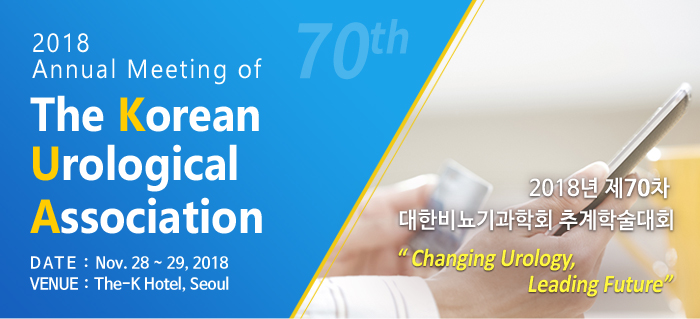|
Infertility & Sexual Dysfunction(구연)
|
Oral Session 2 / Infertility & Sexual Dysfunction (O-020)
Crystal A (3F)
11월28일(수) 13:00-14:00
|
|
|
무증상 남성갱년기증후군 환자에서 남성호르몬 보충요법의 효과 |
| 부산대학교 의과대학 비뇨기과학교실 |
| 박현준, 백승룡, 김경환, 박지훈, 강병진, 박시균, 박남철 |
Objectives: Testosterone replacement therapy (TRT) is effective for treating the symptoms and ameliorating the metabolic consequences of hypogonadism. TRT improves muscle mass, bone mineral density, mood, and sexual performance. However, a significant number of patients have low serum levels of testosterone without any subjective symptoms or complaints. We evaluated the suitability of TRT for patients with non-symptomatic late-onset hypogonadism.
Materials and Methods: Seventy patients whose initial serum levels of testosterone were < 300 ng/dL without any symptoms or complaints were consecutively enrolled and followed for 30 weeks. All patients received 1,000 mg parenteral testosterone undecanoate on day 1, followed by additional injections on weeks 6, 18, and 30. Serological tests (for total testosterone, lipid profile, glucose, and prostate-specific antigen [PSA]) were performed and Body Mass Index (BMI), International Index of Erectile Function (IIEF) score, International Prostate Symptom Score (IPSS), the Aging Males’ Symptoms (AMS) questionnaire, and the Global Assessment Questionnaire (GAQ) were performed at baseline and at the end of the study.
Results: Mean patient age was 56.2 ± 10.5 years. The total IIEF score increased from 44.9 ± 12.9 at baseline to 54.8 ± 13.0 on week 30 (p < 0.001). The AMS score improved from 37.9 ± 11.5 at baseline to 24.6 ± 13.2 on week 30 (p < 0.001). Baseline and 30-week total testosterone levels were 272.2 ± 48.2 and 598.2 ± 52.5 ng/dL, respectively (p < 0.0001). No significant changes were detected in the IPSS, lipid profiles, glucose, BMI, or PSA level. The percentage of patients reporting improvement in the GAQ was 58.6%. Improvements in the sexual desire domain of the IIEF, sexual subscale of the AMS, and change in total testosterone (>300 ng/dL) were significantly correlated with a positive GAQ response. The majority of adverse events were mild, reversible, and of short duration.
Conclusions: Although a patient may not complain of any subjective symptoms at the initial visit, TRT can be considered in patients with low testosterone levels and decreased sexual desire and function. It is postulated that patients with low testosterone levels may not recognize their symptoms. Thus, more specific screening is needed for such patients.
|
|
keywords : Testosterone, Hypogonadism, Treatment |
|

